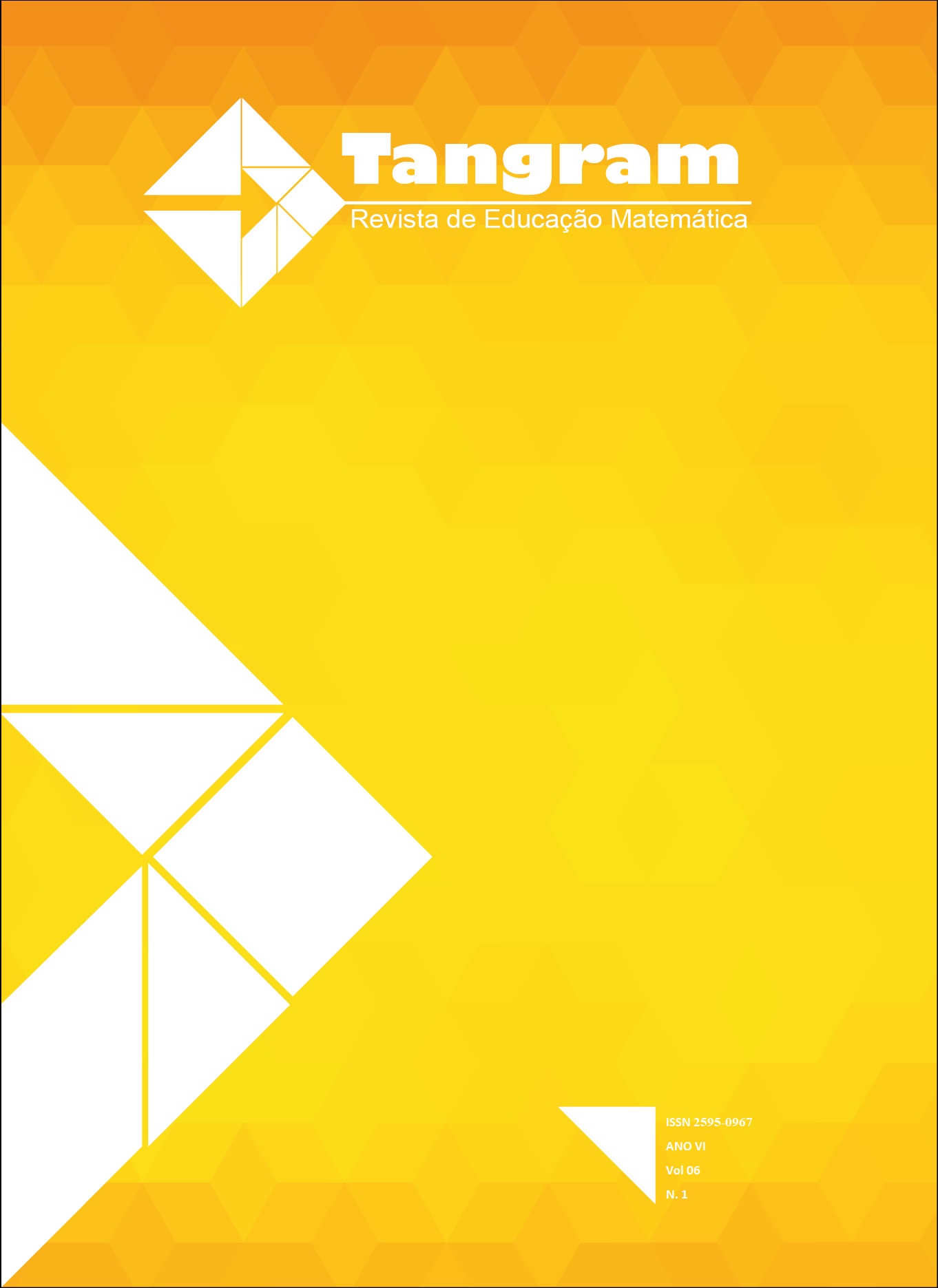O Graphmatica nas práticas pedagógicas no curso de Licenciatura em Matemática: o ensino de Funções
DOI:
https://doi.org/10.30612/tangram.v6i1.16864Palabras clave:
Software, Investigação matemática, Formação inicialResumen
Este estudo teve como objetivo principal refletir sobre a utilização do software Graphmática na prática pedagógica matemática junto aos acadêmicos do curso de Licenciatura em Matemática do segundo ano de uma faculdade pública, no interior do Mato Grosso do Sul, para potencializar o estudo de funções do 1º grau. Nesse sentido, nos pautamos nos estudos de Gáscon, pois compreendemos que ensinar matemática é problematizar, provocar a elaboração de conjecturas, sendo o aluno, protagonista deste processo Para tanto, a tecnologia digital, tal como está posta hoje, pode contribuir para que essa interação seja efetivada permitindo que o estudante relacione aprendizagens anteriores com os novos conhecimentos a serem construídos e incorporados. Como resultados, a análise dessa investigação permitiu observar que mais fundamental do que ter o domínio do software, é proporcionar situações pedagógicas em que se engendra atividades cativantes, que despertem a curiosidade e o senso crítico dos alunos - em nosso caso, dos acadêmicos.
Descargas
Citas
Felice, J. Números: Ideias, linguagens e representações. GAMA EDITORIAL. Vol. 1. Nova Andradina-MS. 2019.
Ponte, J. P.; Brocardo, J.; Oliveira, H. (2006). Investigação Matemática na sala de aula. Belo Horizonte: Autêntica,.
Barco, L., (2008). A Educação e Escola na Era Digital. In: Estefenon, S. G. B., Eisenstein, E. (Orgs.) (2008) Geração Digital: riscos e benefícios das novas tecnologias para as crianças e os adolescentes. Rio de Janeiro: Vieira & Lent.
Borba, M. C., Silva, R. S. R. & Gadanidis, G. (2016) Fases das tecnologias digitais em Educação Matemática: sala de aula em internet em movimento. Belo Horizonte: Autêntica,
Davis, P. J., Hersh, R.,( 1986) A Experiência Matemática. 3.ed. Rio de janeiro: Francisco Alves.
Gascón, J., (2001) Incidencia del modelo epistemológico de las matemáticas
sobre las prácticas docentes. RELIME. Revista latinoamericana de investigación en matemática educativa, Vol. 4, Nº. 2, 2001, pp. 129-160. Disponível em < https://dialnet.unirioja.es/servlet/articulo?codigo=2147202 > Acesso em 14 out 2022.
Gravina, M. A., & Santarosa, L. M. C. (1999). A Aprendizagem da Matemática Em Ambientes Informatizados. Informática na Educação: teoria & prática, V. 2 Nº 1, maio, 1999. Disponível em < https://lume.ufrgs.br/bitstream/handle/10183/20962/000243348.pdf?sequence=1&isAllowed=y > Acesso em 14 out 2019.
Kenski, V. M., (2011). Educação e Tecnologias: o novo ritmo da informação. 8.ed. São Paulo: Papirus, 2011.
Malaca, C. & Néri, I. C. (2007). Guia do Usuário Graphmática. São Paulo: Editora não especificada. Disponível em < http://www.Graphmatica.com/user/GuiaDoUsuario-Graphmáticav2003p.pdf > Acesso em: 14 out 2021.
Marcuschi, L. A. & Xavier, A. C., (orgs.) (2010) Hipertexto e Gêneros Digitais: novas formas de construção de sentido.3.ed. São Paulo: Cortez.
Ponte, J. P. (2003) Investigar, ensinar e aprender. Actas do ProfMat (CD-ROM, pp. 25-39). Lisboa: APM.
Ponte, J. P., Oliveira, H., Brunheira, L., Varandas, J. M., & Ferreira, C. (1998). O trabalho do professor numa aula de investigação matemática. Quadrante, 7(2), 41-70.
Mato Grosso do Sul. (2014). PPP- Projeto Politico Pedagógico do Curso de Licenciatura em Matemática da UEMS de Nova Andradina, Disponível em: http://www.uems.br/assets/uploads/cursos/c9410259627b0b9dbb1ee634e5a3f7c9/projeto_pedagogico/1_c9410259627b0b9dbb1ee634e5a3f7c9_2020-02-18_15-09-35.pdf. Acesso em: 28 abril 2022.
Santaella, L. (2013), Comunicação Ubíqua: repercussões na cultura e na educação. São Paulo: Paulus.
Santaella, L.(2004). Navegar no ciberespaço: o perfil cognitivo do leitor imersivo. São Paulo: Paulus.
Santos, C. A &; Sales, A. (2017) As Tecnologias Digitais da Informação de da Comunicação no Trabalho Docente. Curitiba-PR: Appris.
Wegner, A. (2011). Uma abordagem do uso do software graphmatica para o ensino de funções na primeira série do ensino médio (Master's thesis).
Descargas
Publicado
Cómo citar
Número
Sección
Licencia

Esta obra está bajo una licencia internacional Creative Commons Reconocimiento-NoComercial-CompartirIgual 3.0.
Os autores devem aceitar as normas de publicação ao submeterem a revista, bem como, concordam com os seguintes termos:
(a) O Conselho Editorial se reserva ao direito de efetuar, nos originais, alterações da Língua portuguesa para se manter o padrão culto da língua, respeitando, porém, o estilo dos autores.
(b) Autores mantém os direitos autorais e concedem à revista o direito de primeira publicação, com o trabalho simultaneamente licenciado sob a Atribuição-NãoComercial-CompartilhaIgual 3.0 Brasil (CC BY-NC-SA 3.0 BR) que permite: Compartilhar — copiar e redistribuir o material em qualquer suporte ou formato e Adaptar — remixar, transformar, e criar a partir do material. A CC BY-NC-SA 3.0 BR considera os termos seguintes:
- Atribuição — Você deve dar o crédito apropriado, prover um link para a licença e indicar se mudanças foram feitas. Você deve fazê-lo em qualquer circunstância razoável, mas de nenhuma maneira que sugira que o licenciante apoia você ou o seu uso.
- NãoComercial — Você não pode usar o material para fins comerciais.
- CompartilhaIgual — Se você remixar, transformar, ou criar a partir do material, tem de distribuir as suas contribuições sob a mesma licença que o original.
- Sem restrições adicionais — Você não pode aplicar termos jurídicos ou medidas de caráter tecnológico que restrinjam legalmente outros de fazerem algo que a licença permita.






